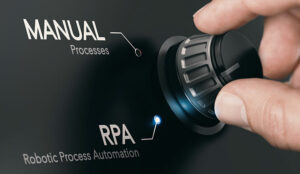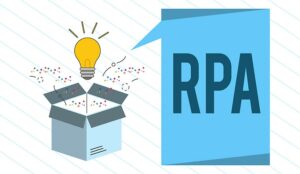There are many blogs populated with articles about chatbots, analytics, and examples of how AI is making traditional contact centre software smarter and more effective. Now it’s time to shine a light on robotic process automation (RPA).
The game is on as businesses try to streamline operations and optimize the customer experience (CX). Organizations are competing to attract and retain customers by delivering great CX while also squeezing inefficiencies and costs out of core processes.
So, where do contact centres fit in? Customer service operations are at the forefront of delivering consistently exceptional CX, and contact centres are making good progress at personalizing interactions and making better connections with customers.
But if a customer peeked behind the operational curtain, they might be surprised by what they see.
The customer-facing part of the interaction might seem smooth and controlled, but on the other end of the phone, agents often have to perform technical acrobatics to execute seemingly simple transactions.
It’s not unusual for agents to use ten or twelve different applications throughout the course of their day and they repetitively perform activities like logging in to multiple systems, navigating through many screens, and copying information from one application and pasting it into another.
Repetitively executing these mundane tasks can crush morale and increase handle times. Additionally, these manual processes are prone to errors. To address these problems and further streamline processes, many contact centres are implementing RPA.
What is Robotic Process Automation?
With RPA, software “robots” interact with systems and data sources to automate rules-based, repetitive digital tasks. These robots can perform processes that human employees perform but they can do it 4-5 times faster and with no errors.
In the previous example of agents navigating multiple systems, the software robots can perform those tasks—logging into each application, navigating screens, and copying and pasting information—with the goal of assisting the agent or completely automating a specific task.
Depending on the task, robots are loaded on back-end servers or individual employee desktops. And depending on the workload, there might be one to 100+ robots performing the same activity. This is because, like human employees, each robot has a finite capacity.
However, a robot’s hourly capacity is much higher than a human’s as robots can work 24/7. Think of an RPA robot as a highly productive team member who works around the clock and never gets burned out on performing mundane tasks. Sounds good, right?
RPA Capabilities
RPA can execute the same digital steps that humans can for repetitive, clearly defined, rules-based processes.
If the process for opening a new checking account always involves running a credit check, entering the application information into the new account screen, and sending a welcome email, that process is a great candidate for RPA.
Typical RPA capabilities include:
- Searching
- Cutting and pasting
- Inputting data into multiple fields and systems
- Moving data around
- Reentering data
- And much more
RPA can be used to augment staff, take hand-offs from human team members to perform repetitive process steps, and assist employees by providing relevant information at the right time.
Example RPA use cases include:
- Activating credit cards
- Fraud claims discovery
- Setting up new utility accounts
- Processing change of address requests
- Producing and emailing employment offer letters
How Does RPA Work?
There are two main ways RPA can be set up, and the choice depends on the nature of the automated tasks and the characteristics of the systems the robots will be interacting with.
Front-end RPA integrations connect directly with desktop applications, but this can be done in multiple ways. As an example, the automation can use other applications’ user interfaces to accomplish its tasks.
This could mean the robots access the exact same screens and perform the same steps as human workers. Imagine looking over the shoulder of a worker as she processes a new claim and then imagine a robot performing the same steps but five times faster!
RPA can also integrate directly with databases and web services in the backend. This is typically done when processes are completely automated and no human intervention is necessary.
Which brings us to our next topic.
Attended vs Unattended RPA
Backend RPA integrations, which enable complete automations, allow processes to be unattended. The robots continuously perform tasks that don’t require human judgment or intervention.
This unattended automation, which completely frees employees from the mundane tasks it performs, is also referred to as robotic automation.
By contrast, attended automation, also known as desktop automation, works alongside human employees, sometimes requiring their input when the robots encounter exceptional situations.
The robots alert employees when they need human input and then continue processing once a response is received. Attended automation robots can also provide workers with contextual help and suggest the best next steps. This capability is particularly helpful to contact centre agents.
Attended and unattended automation aren’t mutually exclusive. Organizations don’t have to use one or the other. They can automate some tasks using attended automation and others with unattended automation to create the best mix of accurate, streamlined processes.
Use of AI in Robotic Process Automation
Not all RPA implementations leverage artificial intelligence. Some tasks are so straightforward that they don’t require AI capabilities. But for more complex tasks AI can be the right tool to make automation possible. Here are some of the forms of artificial intelligence that can enhance RPA capabilities:
Machine Learning
Robots that use machine learning become smarter over time based on more data consumption and human feedback.
For example, if a robot alerts an employee about a slight customer name discrepancy and the employee overrides the alert because the SSN on the incoming paperwork matches the SSN on the customer record, the robot will eventually learn to check the SSN for future name discrepancies.
When robots get smarter, less human intervention is needed.
Natural Language Processing (NLP)
Natural language processing is sometimes called speech recognition, but its capabilities go beyond just recognizing words; it can also identify intent. This means, for example, robots can interpret phone conversations and act accordingly.
Optical Character Recognition (OCR)
Robots that have OCR capabilities can read unstructured text sources such as emails, letters, and scanned documents to identify pertinent data.
This allows these robots to, for example, review a scanned driver’s license, recognize the different pieces of information, and input the data into the right system fields.
“Cognitive” RPA that leverages AI can further elevate automation results.
RPA in the Contact Centre
Contact centres are typically replete with repetitive, rules-based tasks that are good candidates for complete or partial automation.
Additionally, new and seasoned agents can always use an extra helping hand when it comes to resolving issues and performing post-interaction administrative tasks. This is why many organizations are adding RPA to their contact centre software tool kits.
Use of RPA for customer service generally falls into two broad categories.
Self-Service
RPA can be integrated with IVR systems and chatbots to provide complete, unattended automation of self-service tasks.
As an example, if a customer uses a chatbot to set up a new insurance policy, the bot can interact with the customer to collect the necessary information, and an RPA robot can work with the systems behind the scenes to set everything up.
This is an example of advanced call centre technologies working together to transform a process and provide satisfying self-service experiences.
Agent Assistance
With RPA helping customers solve more of their own, simpler issues, agents will find themselves handling a more complex mix of interactions. RPA can help agents solve these tougher problems by listening to their conversations with customers and retrieving relevant knowledge base articles.
Additionally, robots can suggest the next steps during the interaction. And following the conversation, robots can help perform post-contact activities like documenting calls and entering data into back-office systems.
This frees up agent time and focus so they can concentrate on higher-value interactions and delivering satisfying CX.
Benefits of RPA
When designed well and used for the right tasks, RPA can deliver many benefits, including the following:
- Increasing Throughput. RPA robots can be used to augment agent capacity. They work 4-5 times faster than humans and can process transactions 24/7, enabling organizations to turbocharge their throughput. With so many contact centres struggling to find qualified agent candidates, RPA can also be the tool to address labor shortages.
- Ensuring Compliance. RPA robots never fat finger data entry or forget to perform process steps, which increases data accuracy and decreases the likelihood of costly compliance violations.
- Reducing Costs. Not only can RPA increase throughput and augment staff, but it does it cost-effectively. When you consider an RPA robot works around the clock at five times the speed of humans, one robot is as productive as fifteen workers.
- Increasing Employee Engagement. Not many people look forward to a day filled with repetitive, mundane tasks. Automating simple processes means agents can spend more time focusing on complex and engaging problem-solving.
- Easily Scalable. When your organization grows, RPA is flexible enough to easily grow with you. And you don’t need to hire, train, and find space for the additional robots.
Real-World RPA Cases
Real-world case studies can help illustrate just how transformative robotic process automation can be. Here are examples of how three companies have effectively used RPA to streamline processes and meet their business objectives.
Banking
A major, Italian-based financial services group had established a contact centre to provide business process outsourcing (BPO) services to other companies in the industry.
Their 500 agents handled 650,000 calls per month, but the operation was facing some challenges meeting its fraud alert SLAs. Plus, agents spent a lot of time on post-call activities, such as data entry and call documentation.
To address these challenges, the organization implemented RPA. Now, robots provide guidance to agents during fraud investigations, resulting in higher accuracy and lower handle times.
Additionally, robots have also reduced agent administrative burden by taking on tasks like documenting the interaction and filing claims requests.
This has reduced wrap time by 82% and enabled the organization to meet process SLAs 100% of the time. And employee satisfaction has increased substantially.
Telecommunications
The telecommunications industry is highly competitive and characterized by stagnating revenue, making streamlined, cost-efficient processes a must.
One major telecommunications company was struggling with inefficient, manual contact centre processes that were causing errors and delays. In addition, costs were rapidly increasing.
The organization implemented 100 robots to automate 23 back-office processes, with the goals of increasing accuracy, reducing delays, and decreasing costs. The effort included the automation of the process used when customers rent new devices.
These customers now have access to highly accurate services 24/7. The RPA reduced processing times in several areas, including an 80% reduction in the time required to rent a device. The highly scalable solution saved the business $3.5 million over 24 months.
Utilities
A leading oil and gas multinational company wanted to improve the accuracy and efficiency of customer address changes. Their 60 contact centre agents processed 15,000 address changes a month with high error rates.
The automation solution involved creating a single interface for agents to enter address changes. Then robots create new accounts for the new addresses and conduct meter checks. They also update the CRM system.
This effort reduced agent handle times for address changes from eleven minutes to one minute, which increased their capacity to handle more interactions. Additionally, errors were eliminated, which improved CX and did away with costly error clean-up.
Robotic process automation is one of many ways artificial intelligence can be used beneficially in contact centres. RPA can automate repetitive tasks, which makes agents’ jobs more engaging, increases contact centre capacity, and improves accuracy. Other AI solutions can yield similar benefits.
This blog post has been re-published by kind permission of NICE CXone – View the Original Article
For more information about NICE CXone - visit the NICE CXone Website
Call Centre Helper is not responsible for the content of these guest blog posts. The opinions expressed in this article are those of the author, and do not necessarily reflect those of Call Centre Helper.
Author: NICE CXone
Published On: 18th Jun 2021 - Last modified: 20th Oct 2023
Read more about - Guest Blogs, NICE CXone, Robotic Process Automation (RPA)






 NICE CXone combines best-in-class Omnichannel Routing, Workforce Engagement, Analytics, Automation and Artificial Intelligence on an Open Cloud Foundation.
NICE CXone combines best-in-class Omnichannel Routing, Workforce Engagement, Analytics, Automation and Artificial Intelligence on an Open Cloud Foundation. 






























